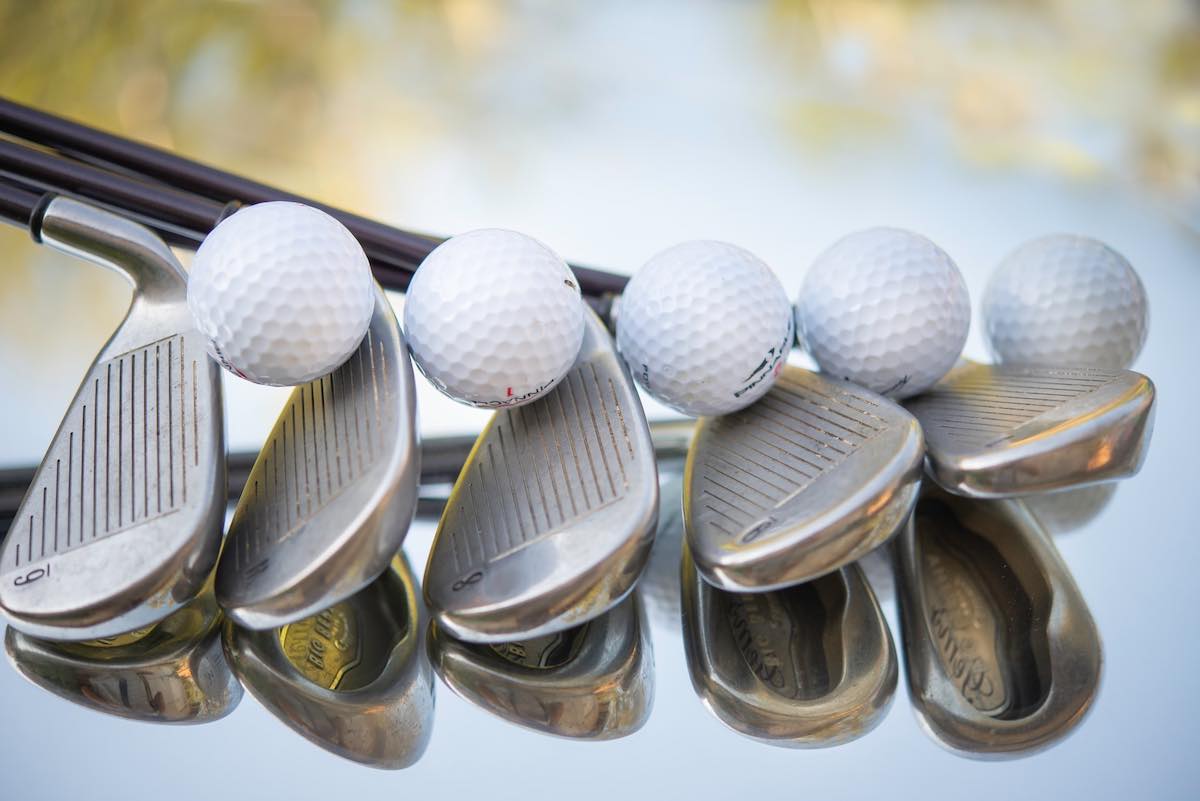In the centuries old game of golf, you are officially only allowed to have fourteen golf clubs in your bag, but are all those golf clubs all that necessary?
A great golf player isn’t necessarily determined by the number of clubs they have at their disposal. Even the pros almost never use all of them. So that begs the question; which golf clubs are the most useful?
The vast majority of professional golfers will be in agreement that the three most essential golf clubs include drivers, wedges, and putters.
Many golfers make the claim that their putter is responsible for taking off more strokes from their scores compared to all other clubs. This is then closely followed by the wedges and then drivers.
To score enough points in a round of golf, you’re going to need the right tools for the job.
This article aims to explain which clubs are the most crucial and why. We want to demonstrate to you the reason for these golf clubs being so important compared to the other ones, and why your golf bag must contain these clubs if you want to improve your game.
The Most Crucial Clubs
The official rules of golf state that players can only carry a limited set of clubs during any round. Despite the fact that stores sell specific combinations of clubs as sets, professionals can use any combination of legal clubs that work best for their game.
This is highly dependent on how the golfer plays. Likewise, whatever standard you play at, the right combination of golf clubs is simply the one that works best for you and the way you play.
The golf clubs that make up the right combination for you depends on your skill level, and where your strengths and weaknesses lie.
Of course, the right golf clubs for a low handicapper are going to be pretty different compared to the right golf clubs for a complete beginner.
For players with a high handicap, it’s beneficial for them to focus on using golf clubs that are easy to use, such as hybrid clubs rather than long irons and 5-3 woods rather than a driver.
More experienced golfers, on the other hand, can use more specialized clubs in order to play a wide variety of shots.
High-Handicappers
Typically speaking, high handicappers cannot hit the driver, because it can put them off their game.
Because of this, they should only carry the following clubs:
- Putter
- Pitching wedge
- 7, 8, and 9 irons
- 3-wood
- 4, 5, and 6 hybrids
Mid-Handicappers
Since more intermediate players have more control over the driver compared to high-handicappers, they should include this club in their arsenal.
Also, mid-handicappers who are good at short games should also include gaps or the lob wedge in their bags.
The following clubs are ideal for mid-handicappers:
- Putter
- Sand wedge
- Pitching wedge
- 6, 7, 8, and 9 irons
- 4 and 5 hybrids
- Driver
Low-Handicappers
For very experienced players or low-handicappers, they must carry the following golf clubs in their bags:
- Putter
- Lob, sand, gap, and pitching wedges
- 2 hybrid
- 9 iron
- Driver
As you can see in our lists above, the most used clubs across the board are the driver, putter, and wedge. This is common in both low and high-handicappers, as well as intermediate players.
Using this as a determiner, it’s safe to say that these 3 clubs are the most important generally speaking.
The Putter
The putter is certainly an essential part of any golfer’s arsenal. Putters are used for low-speed, short, controlled strokes.
They are used primarily for hitting the ball into the hole from a short distance on the green.
Some golf courses, however, have roughs or fringes very close to the green, so the putter might be the best option for a shot from this location.
Putters are typically constructed from either wood or iron, and it has a low-loft striking face.
Additionally, some putters have positional guides, a non-circular grip, and a bent shaft.
The putter is a club that is designed for a very specific purpose within the game of golf. For this reason, the putter is regarded as an indispensable golf club.
The putter is designed to provide you with all manner of technical advantages when you’re on the green.
For instance, the putter is engineered to provide a great impact on the ball, with outstanding glide, the smoothest possible stroke, and the ideal fit regarding the angle of the shaft and the length of the club.
The striking face of the putter isn’t perpendicular in relation to the ground. Instead, it has a small amount of loft with the intention of lifting the golf ball out of an indentation or depression in the ground.
The loft of the putter cannot legally go above 10 degrees. Typically, the loft is approximately 6 degrees.
Also, the putter is unique because it is the one and only club which features a bent shaft. Club makers usually produce putters with the club head attached to the shaft for increased stability.
The reason for the bent shaft is to position of the head in line with the long section of the club. By doing this, the striking face should make contact with the ball at just the right spot on the subhead for the perfect putt.
The reason for this design is to maximize accuracy, as it makes it easier to swing the head through the golf ball.
Many putters feature a hosel to help position the shaft of the club in line with the center of the ball upon impact. Some players find that this helps to improve stability and the quality of the club’s feel.
The Driver
When it comes to the driver, there isn’t a one-size-fits-all club. But that’s not to say that golf club manufacturers haven’t been trying!
There are near infinite adjustabilities, such as movable weight settings, adjustable hosels and the like.
Drivers are used for a tee shot. Because of this, the club is very highly valued for experienced mid to low-handicapped golfers who have better control over their drives.
It is important for beginners to get a feel for different types of drivers before getting on the course.
Drivers are categorized under the class of woods, and initially this is how they were referred to. The purpose of woods are to launch the ball long distances.
Typically, drivers feature a long shaft and a large, heavy club head for maximum top club speed.
Out of every single club in your golf back, the driver is the one that launches the ball the furthest distance thanks to its long shaft and low loft angle.
However, if you don’t have great control off the tee, the increased distance can lead to a decrease in accuracy.
In this day and age, drivers are available in a wide range of different designs, including different club head sizes and materials.
Titanium driver heads allow for a more oversized club head, which increases the striking face of the club, giving the driver a larger sweet spot. Because of this, drivers with titanium heads can be a lot more forgiving than other materials.
Steel-headed drivers, on the other hand, have a much smaller sweet spot. They are less expensive than titanium drivers, though.
There are also composite drivers that are comprised of titanium along with another metal for the best of both worlds. Composite clubs are typically closer to the mid-range in terms of price.
Different Types of Drivers Overview
Titanium Driver
- Oversized club head
- Large sweet spot
- Forgiving
Steel-head Driver
- Smaller sweet spot
- Less expensive
Composite Driver
- Best of both worlds
- Mid-range price

With drivers, there are also a variety of factors regarding the shaft that affect the way the club’s head strikes the ball. The material of the shaft is one of these variables.
Steel shaft have increased weight and decreased flex, but they can produce lower power and a slower swing speed at the point of impact.
The flexability necessary for a driver’s shaft is dependent on the club-head speed. For this reason, low-handicap players desire increased control of the driver that will compensate for the decreased distance.
Graphite shafts increase the club-head speed and therefore cause an increase in distance. Shafts are available in many different lengths, so you can choose a shaft that is perfect for your particular height.
The loft of the driver determines the height at which your ball will fly. Most drivers have a loft ranging from approximately 11 to 18 degrees.
It is desirable to find a driver that has a loft that optimizes the shot’s distance. Loft also increases the roll distance.
As you increase the loft of your driver, it decreases the amount of side spin upon the ball. This can result in slices or hooks.
Because of this, low-handicap golfers typically go for a driver with a loft under 11 degrees. Experienced golfers can usually handle these drivers that have a lower loft and are therefore less forgiving.
One of the more recent innovations in regard to the driver is the introduction of weighted drivers. These weighted drivers that are now on the market are designed for players to have increased control over the flight of the ball.
These weights are removable, and they have a considerable impact on the feel of the driver. The amount of weight on the club and the position of the weights can considerably alter the flight path of the ball.
Wedges
The clubs with the highest level of lost are the wedges. Wedges were designed for shots that ascend and descend sharply.
These include pitch shots, chip shots, strokes on sand, and short approach shots.
Wedges are commonly regarded as a specialized subset of irons, but they really are part of a category of their own.
There are multiple different types of wedges, including the sand wedge, pitching wedge, lob wedge, and gap wedge.
The Sand Wedge (SW)
The sand wedge is specifically designed for hitting the ball out of the bunker. It has a loft of around 56 degrees and 10 degrees of bounce.
Gene Sarazen is credited for inventing the sand wedge as we know it today, and he used it to win both the US and British Open tournaments in 1932.
Modern wedges typically have more mass than the older, original design in order to help drive the club head through firm sand.

The Pitching Wedge (PW)
The pitching wedge is commonly thought of as a basic club that is an essential part of every golfer’s arsenal.
It is known for being the lowest-lofted out of all the wedges. Designed for short-range shots, the loft of most modern pitching wedges are typically around 48 degrees with little to no bounce at all.
After the turn of the century, club makers have started making additional wedges. The two other commonly used wedges are the lob wedge and the gap wedge.
The Lob Wedge (LW)
The lob wedge is the highest-lofted out of all the wedges, with a loft of approximately 60 degrees.
This club creates a very sharp ascent and also a steep angle of descent with minimal roll.
This makes it ideal for chipping onto the green without rolling too far. Lob wedges also typically have a low to mid-bounce.
The Gap Wedge (GW)
The gap wedge is categorized as somewhere between the sand and pitching wedge. It has a lower loft angle than sand wedges and more than pitching wedges.
Gap wedges are one of the newest additions to the wedge category of clubs. Because of this, it is less standardized in terms of design and purpose.
Video: Which Golf Club to Use and When
This is a great video by GolfbidderTV going through the majority of clubs mentioned above. There are some common rules that could help you on the course!
Conclusion
Frequently Asked Questions – Common Golf Clubs
A golfer can carry 14 different clubs during a round of golf.
It’s definitely standard for a golfer to carry a Driver, a Putter, and a mid iron club, like a 7 of iron. This will get you a long way around the course!

